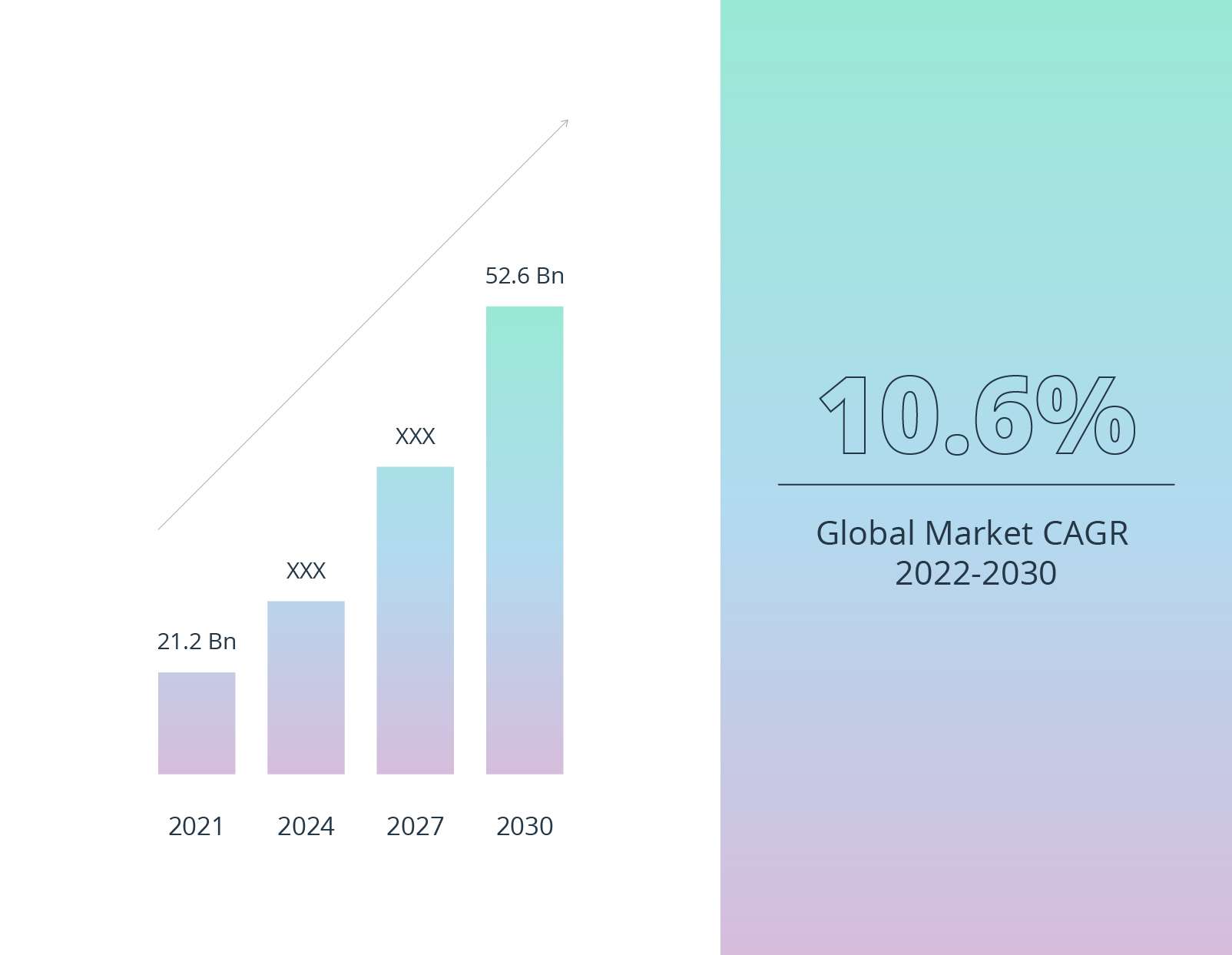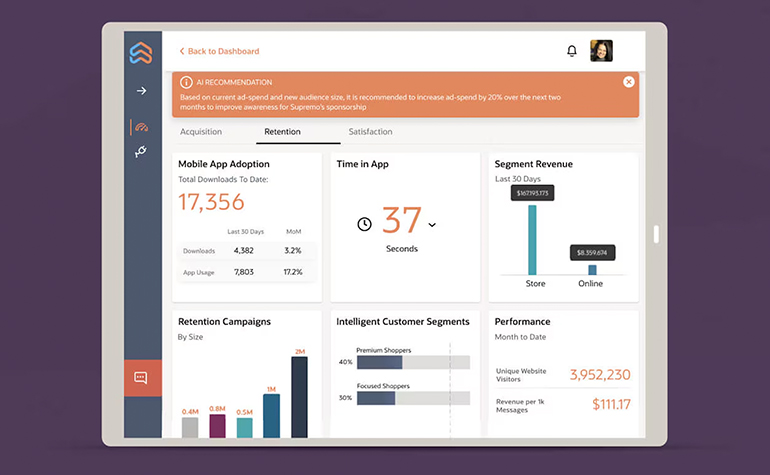The rise of enterprise platform ecosystems is the logical step for businesses that have outgrown available tools and applications: they need to scale fast, accommodate a large number of users, and integrate other software. Comprehensive, integrated enterprise platforms stimulate business growth and help generate revenue. They also provide flexibility and adaptability, allowing big companies — to accommodate the ever-evolving customer needs and help them keep up with the competition.
The enterprise IT platform landscape is dominated by industry heavyweights, including Microsoft, SAP, Oracle, and Salesforce, all of which are igniting a new era in enterprise intelligent automation. Other key players such as as Mendix, OutSystems, UiPath, and Intellias, while smaller, are also tapping into the enterprise market, one enterprise energy management platform at a time.
We are witnessing the formation of a new, highly adaptive ecosystem focused on addressing business requirements by blending low-code app development, robotic process automation (RPA), and other cognitive technologies. The convergence of these technologies is poised to redefine how businesses operate and open up possibilities for advanced new tools, promising a future where efficiency and responsiveness to business specifics take center stage.
Enterprise platforms: business apps & automation workflows
Organizations are increasingly seeking unified solutions to address their business challenges, driving the growth of the enterprise application market. Enterprise platform solutions encompass many types of software, including but not limited to:
- Customer Relationship Management (CRM) platforms assist businesses in managing interactions and relationships with customers and prospects. They typically include modules for sales force automation, marketing automation, customer service, and analytics.
- Business Intelligence (BI) platforms offer tools and technologies for data analysis, reporting, and visualization. They help organizations make data-driven decisions by transforming raw data into actionable insights.
- Enterprise Resource Planning (ERP) systems integrate and manage various business processes, such as finance, accounting, procurement, supply chain, human resources, and manufacturing.
- Supply Chain Management (SCM) platforms help organizations manage and optimize their supply chain operations, including procurement, logistics, inventory management, and transportation.
- Enterprise Asset Management (EAM) platforms manage and maintain an organization’s physical assets, such as equipment, machinery, vehicles, and facilities.
- Business Process Management (BPM) platforms can model, automate, and optimize business processes. They provide tools for process design, execution, monitoring, and analysis.
- Enterprise Content Management (ECM) systems help organizations capture, manage, store, preserve, and deliver information and content like documents, images, and multimedia files.
These applications can be customized for specific business needs and deployed across corporate networks on different enterprise IT platforms. With the rising adoption of geographically distributed teams, remote capabilities, and interconnectivity on a global scale, these applications help employees perform better, improving communication, boosting business efficiency, and uncovering new revenue opportunities.
Enterprise platform market size

Source: Market Research Community
According to analysts, the growing popularity of cloud-based enterprise software applications across industries can be attributed to their strong performance, interoperability features, structural stability, and constant development. Demand for enterprise platforms is further influenced by their integrated cognitive tech-enabled features like analysis capabilities, predictive intelligence, and adherence to regulatory compliance.
The Enterprise Platform market, valued at USD 21.2 billion in 2021, is projected to grow at a CAGR of 10.6% from 2023 to 2030, reaching USD 52.6 billion by 2030, according to Market Research Community.
Enterprise platforms vs. point solutions
When faced with an operational challenge, businesses must choose from many online tools. The availability of enterprise-class business platforms and point solutions complicates decision-making, and the key to making the decision is the understanding that scale is the major difference between enterprise platforms and point solutions. Enterprise platforms have a broad scope, while point solutions are narrowly focused. From this major distinction stem their other differences:
| Enterprise platforms | Point solutions | |
|---|---|---|
| Integration | Across multiple business processes | Limited integration capabilities |
| Data sharing | Facilitate data sharing and visibility across departments | Often operate in silos |
| Scalability | Scale and support large, complex organizations | Limitations in scalability |
| Adoption | Require the whole company to adopt the software to use it to its full potential | Can be used by a small department or even a single person to deal with a specific challenge without requiring everyone to buy in |
Think of it like this: if your business were a house, an enterprise solution would be the foundation, the walls, the ceiling, the windows — the totality of what constitutes the house. A point solution would then be like a doorbell, a smoke detector, or a ceiling fan — laser-focused on solving one problem to improve your quality of life.
How do enterprise platforms work?
Numerous processes run behind the scenes to make a complex enterprise platform function seamlessly. Let’s explore these enterprise platform processes to help determine if this software suits your needs. Keep in mind that this is a general description; actual operations may differ depending on the enterprise application software you use.
- Deployment. The first choice y is deploying the platform eitherin the cloud (SaaS method) or on-premise. On-premise solutions offer better data security and privacy and give you full control of the software. The SaaS method offers better accessibility via the Internet and a more hands-off approach.
- Module implementation. Choose the components of an enterprise platform necessary for your business. For example, an ERP system may include modules for finance, manufacturing, supply chain, and human resources.
- Data integration. The platform gathers data from connected silos and centralizes it, allowing all departments access to the same data as everyone else.
- Process automation. Enterprise platforms automate and streamline business processes by defining workflows, rules, and procedures. Customize and fine-tune these according to your business needs.
- User access and roles. Enterprise platforms provide controlled access to different users based on their roles and permissions within the organization. This is typically configured early in the implementation process.
- Reporting and analytics. This enterprise platform process allows users to generate reports, dashboards, and visualizations based on the integrated data, which are leveraged continuously.
- Customization and integration. Enterprise business platforms often offer integration capabilities, allowing them to connect with other specialized systems or third-party applications used within the organization. They also provide customization options to tailor the platform to specific business requirements.
The key advantage of enterprise platforms is their ability to break down data silos and promote cross-functional collaboration by providing a single source of truth for organizational data and processes. This integration and centralization of information can improve operational efficiency, enhance decision-making, and provide a more holistic view of the business.
Integration is the new gold
One of the key trends (or, rather, standards) of the new is comfort and agility. In order to digest transformation at the speed it is happening today, the new level of integration is the focal point of today’s enterprise platforms. According to business insiders, platform integration capabilities are increasingly vital for enterprises, potentially reaching a make-or-break point. The average number of software applications deployed per company is rising each year. Enterprises use not only off-the-shelf business applications, which often offer built-in integration features, but also a significant number of in-house applications that must be integrated into the overall data ecosystem. And they must work in sync, be fast, and be user-friendly.
Gartner’s 2021 Hyperautomation Survey reveals that 11% of business technologists prioritize Enterprise Integration Platforms (EiPaaS) for business-driven automation.
Integrated solutions are popular for a reason. As enterprise configurations grow more complex, the need for unification and standardization becomes critical. The market has responded by offering comprehensive enterprise integration platforms, providing underlying infrastructure for connecting various apps and solutions involved in business flows. Cloud-based EiPaaS solutions have become the glue that connects applications, databases, legacy products, on-premises software, and modern services into an integrated ecosystem with a high degree of automation.
Microsoft, Salesforce, SAP, and Oracle dominate today’s enterprise integration landscape. Their solutions come equipped with dozens of pre-built integrations and support custom development of automated connections. To speed up development, these platforms offer low-code customization, enabling businesses to set up custom integrations.
Acknowledging the importance of all-inclusive automation, enterprise business platforms are expanding their capabilities with robotic process automation solutions and advanced intelligence tools. Some incorporate them as part of their feature suite, while others opt to implement process automation by integrating with advanced RPA tools like UiPath.
Integrations: connect and automate

Given the increasingly heterogeneous nature of IT environments, users expect greater control over their data and systems. They yearn for data and systems to be translated into coherent formats and yield actionable insights. This transformative approach is paving the way for unconventional integration solutions that bring clarity and tangible benefits to users.
As demand for process control grows, businesses express preference for visible, coherent, and tangible outcomes. Platform and service providers are responding with multi-faceted integrations, offering ready-to-go solutions that elevate interoperability to new levels. The result is accelerated speed, efficient operations, and, most importantly, clear and observable value derived from IT investments. What was once considered non-traditional is now finding its place in the integration landscape.
Within the panorama of integration approaches are many traditional classifications and categories. The following is an unconventional grouping with some examples for a better understanding of the purposes such integrations fulfill for the business:
Product integrations. Microsoft Power Platform unifies people and technology, enhancing business efficiency by offering innovative tools via Microsoft 365, SharePoint®, Azure, and Teams. Staying true to its motto that “businesses run better when everything works together,” Salesforce consistently introduces new products like MuleSoft and Slack, seamlessly connecting customers with services.
Microsoft has 13 distinct product lines that generate more than $1 billion in annual revenue.
System integrations. Oracle’s Cloud Infrastructure services, like SOA, API Management, and Data Integrator, swiftly orchestrate data flows, ensuring seamless connectivity and automation across digital processes from payments to logistics and driving enhanced performance and real-time insights. Microsoft’s Integration Services, which include Azure services, Logic Apps, and API Management, facilitate smooth integration of business apps and data sources. Salesforce’s customizable SaaS systems, coupled with Einstein AI, boost organizational efficiency and collaboration.
As of September 2023, Oracle was the most popular database management system (DBMS) in the world.
Community collaboration. Collaborating with stakeholders, SAP Integration Suite, an open and modular iPaaS, empowers practitioners with tools and technologies to simplify enterprise-wide integration scenarios. Boosting productivity, ensuring governance, and enabling seamless integration across diverse systems, SAP Integration Suite fosters business process interoperability. Microsoft engages with customers, partners, and competitors to enable all kinds of integrations, spanning business processes, Microsoft .NET/Java interoperability, and web services.
SAP Business One, an ERP software platform, offers more than 500 industry-specific integrations.
Compliance-focused integrations. In the interconnected business landscape, standard alignment is crucial for complying with industry regulations, security standards, and software framework requirements when dealing with complex and diverse data sources. Enterprise data integration tools from leading service platform providers support various standards, from de facto standards like workflow engine usage and protocols to built-in connectors and other elements facilitating seamless connections to diverse applications. Major integrated service platform providers guarantee adherence to regulations and standards such as ISO, the GDPR, CMMI, PCI DSS, and so on up to the latest EU AI Act, spanning every industry vertical so that businesses can trust their data and synchronize their processes.
65% of risk and compliance professionals believe that utilizing technology to automate processes would cut down on complexity and costs in their field.
Business platform evolution: from tools to hyperautomation enablers
Today, the enterprise software market shows a distinct trend towards platformization. Instead of standalone monolithic applications, businesses prefer integrated environments with multiple modular components supporting agility, scalability, collaboration, and innovation. The total enterprise software market is growing steadily and is projected to reach US$292 billion in 2024 showing the increasing popularity of intelligent automation solutions comprising enterprise platforms.
Enterprise software market revenue

Source: Statista Market Insights
As unbelievable as it may sound, business platforms started long before what we today call “the digital era.” Enterprise resource planning (ERP) systems date back to the 1960s, for instance, when the manufacturing industry faced the challenge of tracking and monitoring growing inventory and managing related logistics and purchasing.
This is when the industry made the first quantum leap by adopting manufacturing requirements planning software. The first-ever Material Requirement Planning (MRP) solution was the result of cooperation between J.I. Case, a construction machinery manufacturer, and IBM, and offered basic inventory control.
With the evolution of manufacturing processes involving an ever-growing number of departments, functions, and people, resource planning solutions became increasingly complex, growing into fully featured enterprise control centers that could be customized for businesses of any size and nature.
As a concept, customer relationship management (CRM) is even older — in fact, it has always existed alongside trade itself, taking it back thousands of years. However, the first attempts to automate customer relationship management and accounting were made in the 1980s with the invention of customer database marketing. The era of digital CRMs began with the launch of Act!, a customer contact management tool that eventually evolved into a complete CRM system.
Today, CRM systems have turned into sophisticated data analytical and reporting solutions relying heavily on data intelligence. They are closely integrated into enterprise processes and handle massive volumes of data related to customer interactions with the ultimate goal of boosting sales.
The highest rung in this evolution ladder is enterprise hyperautomation, leveraging robotic process automation, artificial intelligence, and machine learning to automate business processes. The hyperautomation technology accelerates and facilitates enterprise ERP and CRM flows cranking up their productivity.
6 key enterprise platform applications
Today’s market for ERP and CRM solutions is dynamic and diverse. There are a variety of products that can meet the requirements of businesses of any size and in any industry. Let’s look at the front-runners who are setting the trends in these areas of software development.
Overview of 6 best enterprise platform applications
| Software | G2 ratings | Capterra ratings |
|---|---|---|
| Enterprise Resource Planning (ERP) | ||
| Microsoft Dynamics 365 | 3.9/5 | 4.4/5 |
| Oracle Fusion Cloud ERP | 4.1/5 | 4.3/5 |
| SAP S/4HANA Cloud Public Edition | 4.5/5 | 4.4/5 |
| Customer Relationship Management (CRM) | ||
| Salesforce Customer 360 | 4.3/5 | 4.8/5 |
| Microsoft Dynamics 365 Suite | 3.8/5 | 4.4/5 |
| Oracle Cloud CX Platform | 3.9/5 | 4.3/5 |
*G2 and Capterra ratings accessed 6/2024
Enterprise Resource Planning (ERP)
Global leaders in software product development offer proprietary ERP solutions that seamlessly integrate into ecosystems built on the basis of integration platforms by the same providers. This sector of the enterprise automation market is dominated by Microsoft, Oracle, and SAP, each offering a fully featured ERP solution.
2023 Magic Quadrant™ for Cloud ERP for Product-Centric Enterprises

Source: Gartner, October 2023
Microsoft Dynamics 365
- For businesses that choose Microsoft as the core cloud service provider, the Microsoft Dynamics 365 application suite can fit all the requirements for a comprehensive ERP system. Microsoft Dynamics 365 can be flexibly deployed using both Microsoft Azure cloud services and on-premises infrastructure, if necessary, and represents a fusion of intelligent automation, artificial intelligence, low-code development, and other cutting-edge technologies.
- As a result, Microsoft offers its enterprise customers an end-to-end solution reshaping the very approach to business workflows:
- Process automation accelerating flows, boosting productivity, and facilitating inter-departmental collaboration.
- Flexible integrations with multiple native and third-party apps allowing companies to create complete platforms.
- Built-in intelligence and data management providing unique insights into every process in the enterprise.

The advanced business process automation, business intelligence, and data management capabilities that are the trademark of Microsoft ERP apps can lay the groundwork for complete connected enterprises tying together processes across departments. Microsoft Dynamics 365 can streamline workflows for global companies in multiple industries including supply chain and logistics, commerce, finance, and human resources.
Oracle Fusion Cloud ERP
Another example of enterprise resource planning software, Oracle’s suite of cloud SaaS applications introduces organization into multiple business processes across an enterprise: resource planning, logistics and supply chain management, advertising, and others. Analytical and decision-making processes are enhanced with AI capabilities that afford insights into multiple business areas.

Choosing Oracle Fusion Cloud as their ERP solution, companies can leverage the notable benefits of this multi-featured product:
- Modular architecture allowing businesses to choose and deploy the services they need in any sequence.
- Rich embedded AI-based analytics enabling accurate forecasting and predictive planning to validate decision-making.
- AI-driven automation of up to 96% of business processes freeing the team’s time for strategic initiatives.
Oracle Fusion Cloud ERP can help enterprises take their productivity and efficiency to the next level by accelerating flows and opening new innovation opportunities. By automating multiple functions in project management, supply chain, procurement, financial services management, and other departments, Oracle Fusion Cloud ERP gives businesses a new competitive advantage.
SAP S/4HANA Cloud Public Edition
This ready-to-go ERP solution by SAP is set up to immediately introduce industry best practices into business workflows. Used in a variety of industries such as manufacturing, energy and facility management, finance, and public services, SAP S/4HANA is perfectly suited to enable growth and development alongside scalable cloud resource consumption.

With SAP S/4HANA, enterprises benefit from a number of advanced features supported by innovative technologies, such as artificial intelligence, machine learning, and robotic process automation:
- Preconfigured out-of-the-box business processes conforming to the applicable industry standards.
- Flexible process customization enabling dynamic digital transformations.
- AI-based analytics opening up unique data processing opportunities.
SAP S/4HANA is a go-to solution for enterprises looking for an intelligent ERP system that can meet the needs of the most sophisticated organizations and propel them into the future by bringing structure and order to multiple workflows.
Customer Relationship Management (CRM)
The current CRM landscape includes globally recognized names such as Oracle, Salesforce, and Microsoft. The fact that these heavyweights have found a place for a CRM tool in their expansive product ranges is hardly surprising.
2023 Magic Quadrant™ for the CRM Customer Engagement Center

Source: Gartner, 2023
Salesforce Customer 360
A definite leader in CRM solutions ratings, Salesforce offers Customer 360, an all-inclusive customer relationship and communication platform featuring state-of-the-art technologies (artificial intelligence, connected data, and advanced integration with multiple apps) that introduce automation and connectivity into workflows.

A completely customer-focused solution, SAP CRM facilitates processes in every area of customer relationship management — sales, marketing, and support — enhancing the team’s experience with groundbreaking technologies:
- Connecting data across multiple applications and functions, thus creating an enterprise-scale data platform supporting customer communications with relevant insights and real-time updates.
- AI-powered automated workflows for sales, marketing, retail and ecommerce, customer service enabling flexible customization and personalization.
- Integration of dedicated apps for building efficient synergies and boosting productivity and collaboration of customer-facing teams.
Microsoft Dynamics 365 Suite
The vast family of Microsoft Dynamics 365 products naturally includes a CRM solution to allow clients to leverage the effectiveness of Microsoft cloud computing in the area of customer relationships. Microsoft Dynamics 365 offers an integrated suite of customer relationship management applications designed to support sales, marketing, customer service, finance, and other functions. Relying heavily on artificial intelligence, Microsoft Dynamics 365 CRM rethinks the approach to customer interaction, shifting the focus to data-guided relationships and sales automation.

A rightful member of the Microsoft line of products, Dynamics 365 fits seamlessly into ecosystems based on Microsoft infrastructures and can be enhanced and customized using apps from Microsoft Power Platform.
With AI at its core, Microsoft Dynamics 365 puts customer-related processes on autopilot, boosting conversions and enabling strong client relationships:
- AI-powered insights laying the foundation for highly personalized campaigns and validated customer-centric activities.
- Predictive forecasting that allows sales teams to prioritize opportunities and make data-driven decisions.
- Process automation improving productivity and ensuring real-time data accuracy.
Oracle Cloud CX Platform
Among numerous Oracle cloud services, businesses looking for a reliable CRM solution should consider the Oracle Cloud CX Platform, which connects various types of business data pertaining to customer relationships. Targeting both B2B and B2C customers, Oracle offers a truly omnichannel CRM solution for businesses in any industry.

Packed with advanced technologies, Oracle Cloud CX Platform has tools for all kinds of sales, marketing, and service activities powered by top-notch cloud engineering:
- Connected data management joining all relevant information into a unified network and helping to build unique data-driven experiences for both customers and employees.
- AI-assisted content creation enabling unprecedented personalization and generation of multiple content formats suitable for distribution over various channels.
- Flexible integration with any enterprise applications, both on-premises and cloud-based, extending the system’s functionality with the most innovative technologies.
Low-code automation platforms

This pioneering approach to software development is getting a lot of traction in enterprise intelligent automation because of its ability to facilitate and speed up development. While powerhouses such as Salesforce and Microsoft enable enterprise ERP customization with low-code automation features within their platform offerings, there are also dedicated tools and platforms that create an intuitive environment for prototyping and building custom software to achieve scalability without complex programming.
The low-code approach is going mainstream not only among small and midsized businesses but also among large enterprises that recognize its potential for accelerating process automation. The market has responded by introducing low-code options in enterprise software platforms, such as those offered by Microsoft and SAP, and proposing complete low-code application platforms (LCAP).
Depending on the degree of low-code adoption, businesses choose either the path of building complete end-to-end ecosystems that also support low-code development or the path of extending their existing infrastructure with applications created using dedicated solutions such as Mendix development services.
The market for low-code technologies is growing rapidly and is forecast to reach almost USD 32 billion in 2024.
But with all its advantages, low-code is no silver bullet for businesses focused on deploying rich intelligent automation platforms. The graphical development environment relies on complex code running under the hood. Low-code solutions may be enough if you only use pre-programmed functions of a low-code tool. If, however, you need custom development, the best choice is to partner with an expert that can help you extend the platform’s functionality and implement your desired configuration.
Businesses opting for a low-code approach can choose from a wide selection of both standalone tools and low-code functionality within larger enterprise ecosystems. In either scenario, different low-code enterprise software providers bring distinct advantages:
- Mendix, the leader of 2023 Gartner Magic Quadrant, is a holistic low-code development tool with a smooth learning curve. It is appreciated for its flexibility and scalability and a wide set of features that allow businesses to develop web and mobile apps in a transparent graphical interface.
- Microsoft Power Apps is a low-code workflow automation solution within the Microsoft family, allowing for the development of secure and robust enterprise-level applications. Products built using Power Apps are easily integrated into the Microsoft ecosystem, making Power Apps the go-to solution for businesses that have adopted Microsoft as their main provider.
- OutSystems, another player on the market of independent low-code solutions, is focused on citizen development, prioritizing simplicity and intuitiveness. OutSystems is also rather strong on integration, supporting multiple pre-built connectors.
- Salesforce Lightning Platform is also highly ranked in Gartner’s rating of low-code tools. The platform is suited for low-code building, customizing, and personalizing apps using a graphical user interface and a library of reusable components, turning app creation into an intuitive process. Needless to say, integrations with other Salesforce products are natively supported.
Centralization around tech giants: Salesforce, Microsoft, SAP

With the abundance of intelligent process automation tools on the market, enterprises still tend to opt for services provided by global industry leaders. In 2023, Microsoft attributed 16% of its growth to automation products, while Salesforce recorded 18% growth of platform services in January 2023 compared to the same period in 2022.
These statistics are a direct indicator of the adoption of enterprise software platforms across the business universe. Aside from the decades-long reputations these brands have earned with their customers, such trust has roots in multiple practical benefits of the platform business model architecture:
- Higher efficiency as a result of automation of repetitive tasks across various functions
- Process consistency across multiple departments through the use of integrated enterprise software solutions
- Data-driven decision-making relying on accurate mining and processing of large volumes of business data
- Cost optimization resulting from reduction of manual labor and more efficient resource allocation
- Improved monitoring and visibility by implementing centralized solutions
- Advanced agility, allowing businesses to adapt to changing requirements
- Innovation opportunities through access to cutting-edge technology solutions provided by industry leaders
- Greater sustainability boosted by smarter resource distribution and supply chain transparency
Recognizing these enterprise platform benefits, an increasing number of companies across industries choose to take the first step by implementing intelligent automation, utilizing solutions provided by global platform providers, and integrating intelligent automation services offered by reputable IT companies to further optimize their processes.
Key takeaways
In the era of digital advancements, introducing innovations doesn’t necessarily imply disruption; instead, it serves to enable and evolve. Various factors drive today’s IT market, including businesses’ global ambitions, the emergence of innovative software solutions from both major providers and smaller developers, a customer-centric approach emphasizing user experience, and sustainability concerns prompting organizations to manage their environmental impact. Enterprise platforms have emerged as a response to these seemingly contradictory trends, providing a foundation extensive business infrastructure.
Consequently, the evolution of enterprise IT involves the logical adoption of integrated solutions — characterized as quick, interconnected, and resource-efficient — that support low-code customization and advanced automation.
In the near future, we anticipate a shift away from distinct CRM, ERP, and similar systems. Instead, versatile platform solutions for growing companies that offer out-of-the-box capabilities tailored to meet individual requirements are likely to gain more traction. While enterprise software solutions become more intricate, the user experience tends to simplify, paving the way for unique innovations as platform development services streamline business processes and handle routine tasks.
These platforms will predictably be enriched with the new and ever-evolving features of AI and machine learning, RPA, and LCAD, with more being seamlessly integrated every day to propel business growth. The convergence of these technologies within a unified platform promises a future where businesses can thrive with unprecedented efficiency and adaptability.
As a technology partner and system integrator, Intellias is committed to ensuring the meaningful integration of platforms and their features — not just technological disruption. Our objective is to make digital solutions not only revenue-generating but also accessible, actionable, and resilient. Recognizing the complexities of modern markets, we specialize in translating these requirements into practical business solutions. We view digital transformation as the strategic application of the right technology within a specific business environment.




